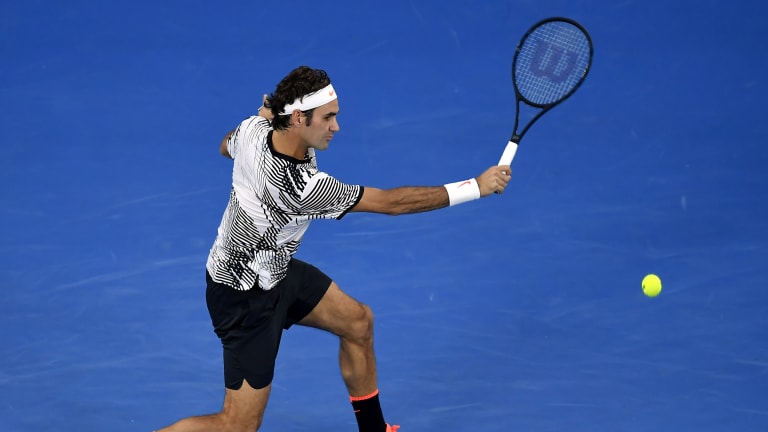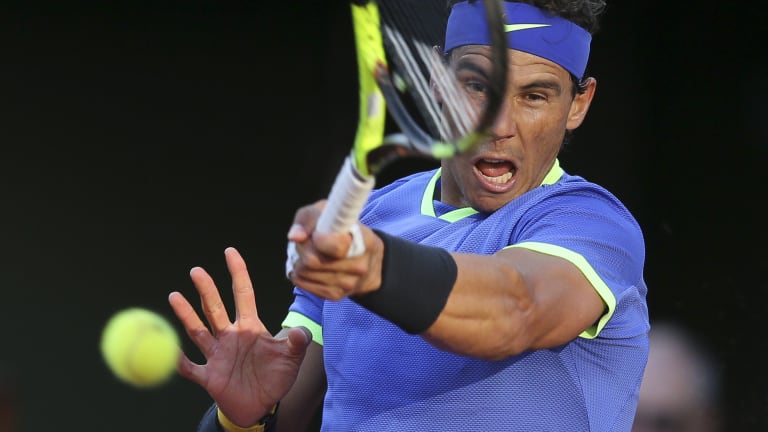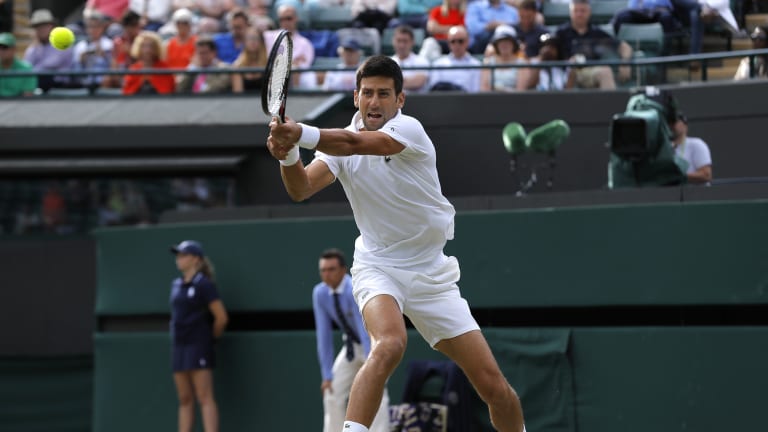WATCH—The fourth episode of The Ten: Seasons airs on Sunday at 8 p.m. EST:
Book Club: The Circuit reflects on the remarkable 2017 ATP season
By Steve Tignor Dec 02, 2018Madrid, Spain
Fabian Marozsan saves 11 set points, wins pair of Madrid tie-breaks to defeat Aslan Karatsev
By TENNIS.com Apr 24, 2024Pop Culture
Coco Gauff dishes on 'embracing adulthood' in TIME magazine's May cover story
By Baseline Staff Apr 24, 2024Pick of the Day
Roberto Carballes Baena vs. Dominik Koepfer, Madrid
By Zachary Cohen Apr 24, 2024Madrid, Spain
Caroline Wozniacki stumbles in clay comeback, exits Madrid in nostalgic Errani match
By David Kane Apr 24, 2024Madrid, Spain
Rafael Nadal says he is not 100% fit ahead of Madrid debut and unsure about playing Roland Garros
By Associated Press Apr 24, 2024Line Calls
ATP Mutua Madrid Open Betting Preview
By Baseline Staff Apr 24, 2024Madrid, Spain
Despite jet lag, Sloane Stephens keeps winning in Madrid with big goals for clay swing
By David Kane Apr 24, 2024Social
It's a girl! Belinda Bencic welcomes her first child, a daughter named Bella
By Baseline Staff Apr 24, 2024Madrid, Spain
Naomi Osaka victorious in Madrid return, defeats Greet Minnen for first clay win since 2022
By David Kane Apr 24, 2024Book Club: The Circuit reflects on the remarkable 2017 ATP season
Published Dec 02, 2018
Advertising
Advertising
In this edition of the Book Club, Rowan Ricardo Phillips and I discuss his new book on the remarkable 2017 ATP season, The Circuit.
Rowan,
Congratulations on The Circuit. This is the type of book that a lot of us dream of getting a chance to write: A wide-angle reflection on the game, told from a personal viewpoint. It's also the type of book that tennis could use more of; every year brings half a dozen deep takes on baseball in the U.S., but tennis rarely gets that kind of beauty-of-the-game treatment. You've done it well here, with your look back at the 2017 men’s season.
I was surprised by how much I had forgotten from that year, despite the fact that I enjoyed the Rafael Nadal-Roger Federer co-renaissance that defined it as much as any other fan. I had specifically forgotten that 2017 began with a match between Novak Djokovic and Andy Murray in Doha that was billed as an opening salvo in the battle for the ATP’s future. Two weeks later, Djokovic and Murray lost early at the Australian Open, Federer and Nadal played a five-set final, and an entirely different future played out, one that lasted until Wimbledon this year.
That’s one of the beauties of tennis: It’s history is always precarious, always in flux, subject to inexplicable but entirely normal rises and dips in confidence, as well as unforeseeable injuries—it really is a sport of individuals, and a very human one. Just when you think the men’s game looks set to continue in one direction, that’s when it will go off in another one. Djokovic’s own resurrection at Wimbledon in 2018 was exactly as stunning as Federer’s at the 2017 Aussie Open.
Did you set out to write about the 2017 season, or did it strike you as it went along that it was a special period that you wanted to chronicle? And more generally, as someone who writes and teaches poetry for a living, and who also plays tennis recreationally, is there something in the sport that you find relates to your work?

Book Club: The Circuit reflects on the remarkable 2017 ATP season
© AP
Advertising
Steve,
I'm reminded a bit of Toni Morrison saying that she ended up wanting, practically needing, to write novels to fill a void; so she started to write the stories she'd been wanting to read and hadn't yet found.
In my reading life as well as in my tennis life I was feeling something building inside of me, a hunger for the type of story that The Circuit ended up becoming. I enjoy really good tennis writing, I always have; and your work has been a part of that for a long time. But the idea for the book came from a series of curiosities that were building in my mind as I watched the second half of the 2016 season play out. It seems like a world ago now but we didn't know what kind of Federer we'd see after his fall in the Wimbledon semifinal against Milos Raonic. We didn't know if Rafa's loss fourth-round US Open loss to Lucas Pouille was the final nail in the coffin of the dominant Rafa. (He didn't even win Roland Garros that year—Imagine!). We didn't know what an ATP tour with Murray as the top dog would look like, feel like, or be.
The top of the men's tour had had such a familiar shape for so long. But as we headed to the start of the 2017, I felt like I was watching water simmer and slowly come to a boil. Had Raonic arrived? Had Pouille broken through? Had Gael Monfils become a contender? Was Stan going to go hard after Wimbledon to complete the career Grand Slam? There was no way of knowing how the 2017 season would play out, but all of the options seemed to me a story waiting to be told. And what a story it turned out to be!

Book Club: The Circuit reflects on the remarkable 2017 ATP season
Advertising
Regarding playing tennis and writing, I don't find that the writing informs the playing. When I play, I'm not a writer. Like most players, so many things that I am bubble to the surface as I play, I just don't think that being a writer is one of them.
That said, there's a way that playing informs the writing. An exchange of groundstrokes, the art of serving and returning, these are all conversations. They have their situations and moods––staying in a rally, looking to attack and end a point decisively, at times ferociously, changing speeds and spins, flipping the script on your typical playing style to attack a weakness, the historical memory that tugs at you when you play someone you've played before, improvisation, anxiety, embarrassment, isolation, joy––these feel like explorations of the art of writing and the glory of storytelling to me.
Talking tennis isn't like talking about any other sport: you can be talking about one particular point in a match from yesterday and a second later you're talking about a match from four years ago that's relevant to that moment in yesterday's match, which makes you remember that the two matches were on different surfaces, which then leads you down another rabbit hole. You can get beautifully lost and then found again in a good conversation about tennis like no other sport, like no other thing really––poetry perhaps. No doubt I'd be an entirely different writer if I didn't play tennis.
Rowan,
The Circuit seems ideally suited for off-season reading, when tennis finally gives us time to take stock of the tour, without having to worry that we're missing any new score lines from Chengdu or Linz.
One of the things I don't like about the length of the tennis schedule is how difficult it becomes to consider each season as a separate span of time, with its own, complete story arc that we can enjoy while it lasts and safely put behind us when it's over, the way we can with team sports. Your book does a good job of giving us a sense of the endlessness of each season, while making some sense of 2017 by itself.
You say the idea for the book began to come to you during 2016, as Federer and Nadal struggled and a new era seemed like it might be arriving. What did you make of what actually did happen in 2017, when Roger and Rafa had their Indian Summer? I found their comebacks satisfying and exciting, but I also wished they had been challenged a little more. After Australia, the Slams all came so easily for them.
Advertising

Book Club: The Circuit reflects on the remarkable 2017 ATP season
© AP
But The Circuit, like I said, is less about analyzing the top players' seasons, and more about taking a step back and appreciating those players, and the immersive nature of the sport, from a lyrical distance. I like your descriptions of a variety of topics: The differences between watching tennis in Spanish and English; the way the Australian Open brings a new sense of order to our lives each January; the way the grass season is both a blip on the schedule and the most intense time of the year; the instinctiveness at the core of Djokovic's game; the "wry chicanery" of Murray's shot selection; the way Rafa "has somehow managed to spend a lifetime making outfits no one should be able to look serious in seem full of intent."
For a tennis fan, the sport can seem less like a diversion or a hobby, and more like an alternative universe that we can visit through our television sets any time we like, from January to November. Wherever we are, the seasons change, but it's (almost) always summer in the tennis world. You write in the book that you watched virtually every men’s match in 2017; That's a modern way of spectating, one that wasn't possible before online streaming, 24-hour sports channels, and social media. With The Circuit, I think you’ve done the best job yet of narrating this new world, and the new, more obsessive relationship with the game that it has allowed fans to enjoy.
Advertising

Book Club: The Circuit reflects on the remarkable 2017 ATP season
© AP
Steve,
You know, as I was writing this book I trusted the process (I'm a big trust-the-process person) and thought that, if I got the angles right, The Circuit would find its readers. And as I think about what you're saying, I think you’ve nailed it. When you step back from professional tennis for a moment, you notice the way in which it, like so few sports, spans the calendar year. In other words, it experiences time as we do: year to year, without our new resolutions and promises that we either fulfill or don't. But something about tennis makes it difficult to experience in that way: as a season in and of itself, the way we do, say, a season of baseball or basketball.
Much of this is due to the constant shuffling around that players do from tournament to tournament. It's way too much and I feel for them. Spectators can tune out Gstaad or Chennai and wait for whatever they think is the next big tournament, but most players can't. They move and move and move, chasing the sun until they can't chase any more and end up indoors to close out the year. One of the things that was fun about writing The Circuit was not letting go. I watch all of those matches anyway, but to really lean in and stay with them, tournament after tournament, and see how the fortunes shift––that brought both the glory and the grind of the game into focus in a way that I'll cherish forever...and that I hope I captured in the book.
What happened to Roger and Rafa in 2017? Roger came back fresh, but the real key was the change of approach with his backhand: he played off that wing with renewed vigor and imperative; less slice and more bad intent. Rafa served better than ever that season. And the rest of the tour seemed to freak out a bit. Andy, Novak, and Stan were around but struggling for fitness until all three packed up their stuff for the year to heal up and do a re-think just as Roger and Rafa had done in 2016. And no players aside from those three had a history of keeping up with Roger and Rafa in the majors. That's how you end up with tournaments like we had in 2017 at Roland Garros, Wimbledon and the US Open. There was a dragon waiting at the back of the draw of each of those majors and no dragon killers to be found. It almost seemed as though the tour thought Roger and Rafa were done and would just go away.
Also, the men’s draw at the 2017 Australian Open was, while earned, pretty funky. It was chock full of players riding career-high rankings into the start of the season but with very little in the way of a pedigree in the big tournaments. Nevertheless, Grigor Dimitrov had Rafa dead to rights in their semifinal in Melbourne; and Stan Wawrinka had Roger in his sights in the other semifinal in Melbourne; Nick Kyrgios lost to Roger by a millimeter in Miami; Philipp Kohlschreiber bageled Nadal in the opening set of their matchup in Miami; and David Goffin got absolutely jobbed by Cedric Mourier in his match against Nadal in Monte Carlo.
An entire sense of a tennis season can shift by one ball clipping a line or the tape of the net. Part of what was so much fun in writing The Circuit was revisiting those types of matches and living in the moment of those razor-thin differences between victory and defeat. That’s where the story of what happened and the story of what could have happened exist simultaneously. And that’s how I tend to think of tennis: as a drama of is, and almost was. That’s what excites me; that’s what it’s all about.